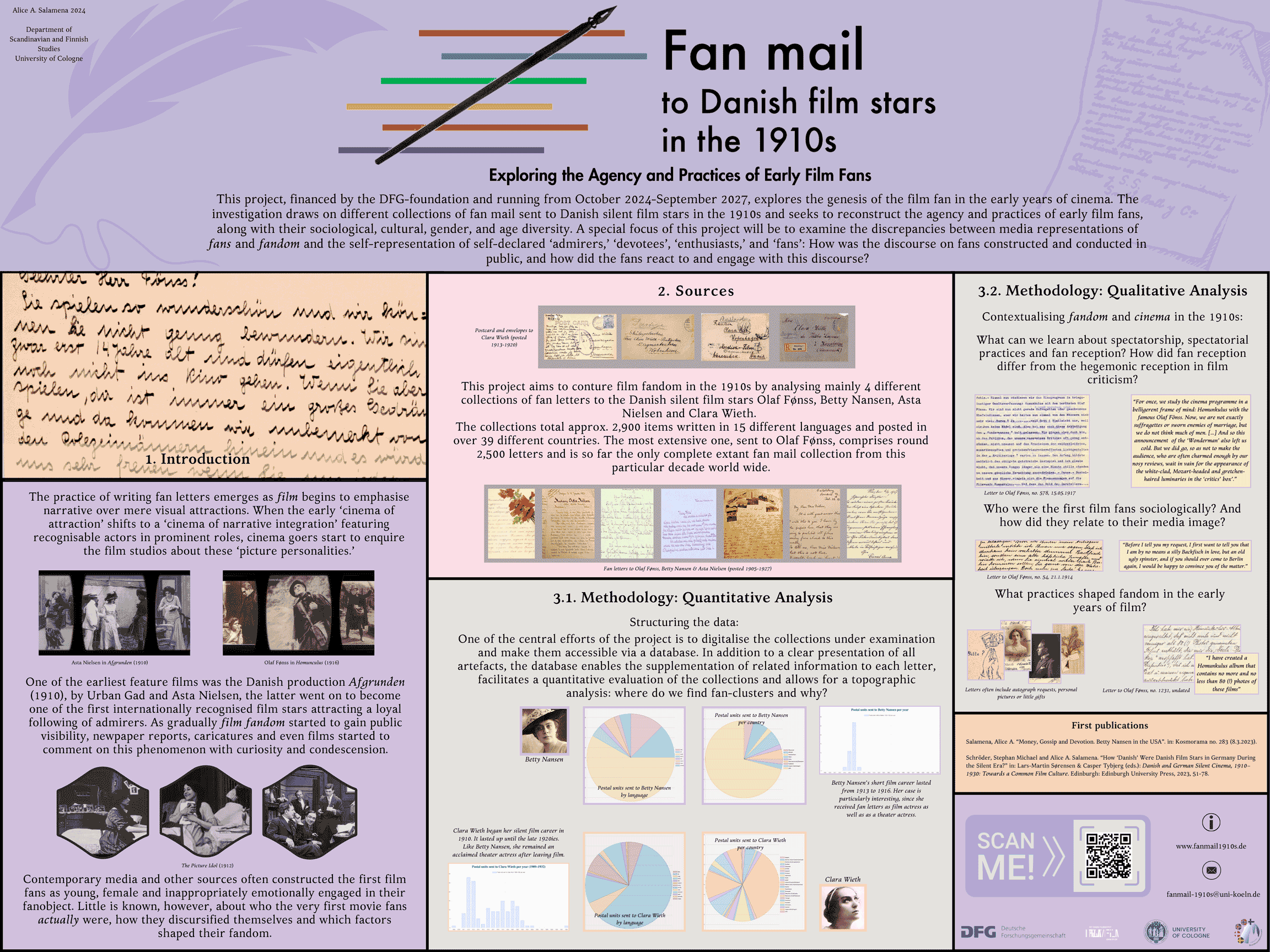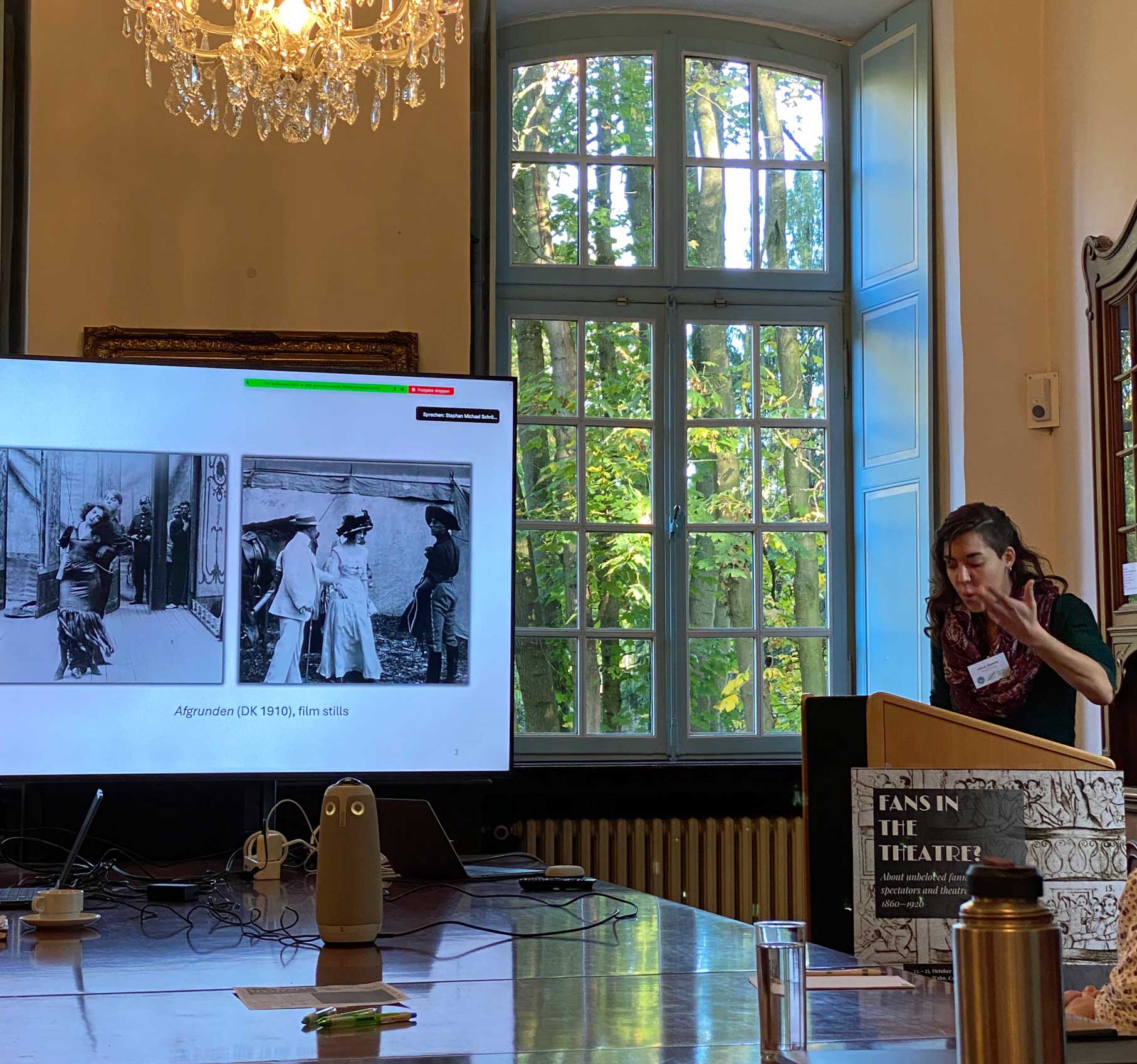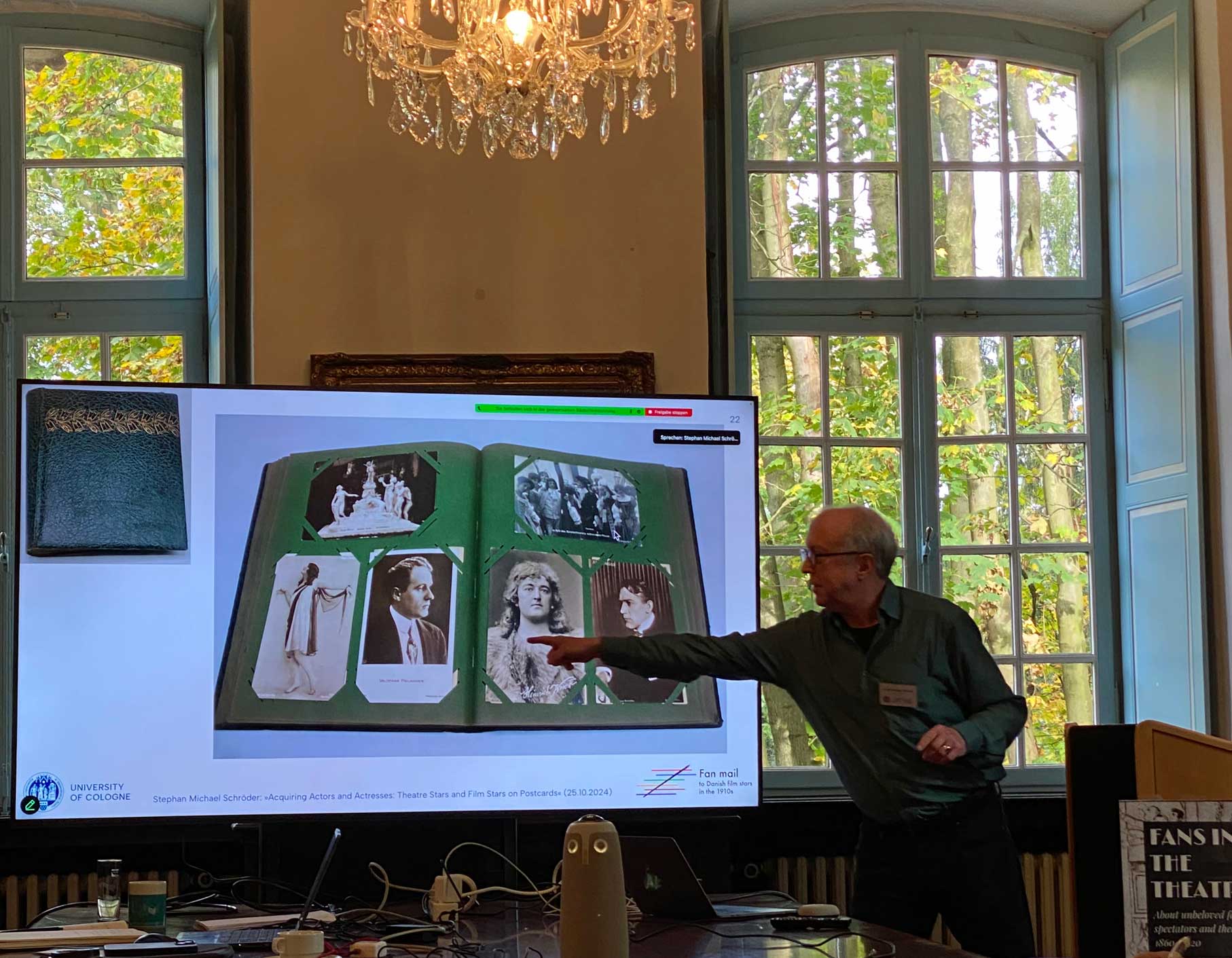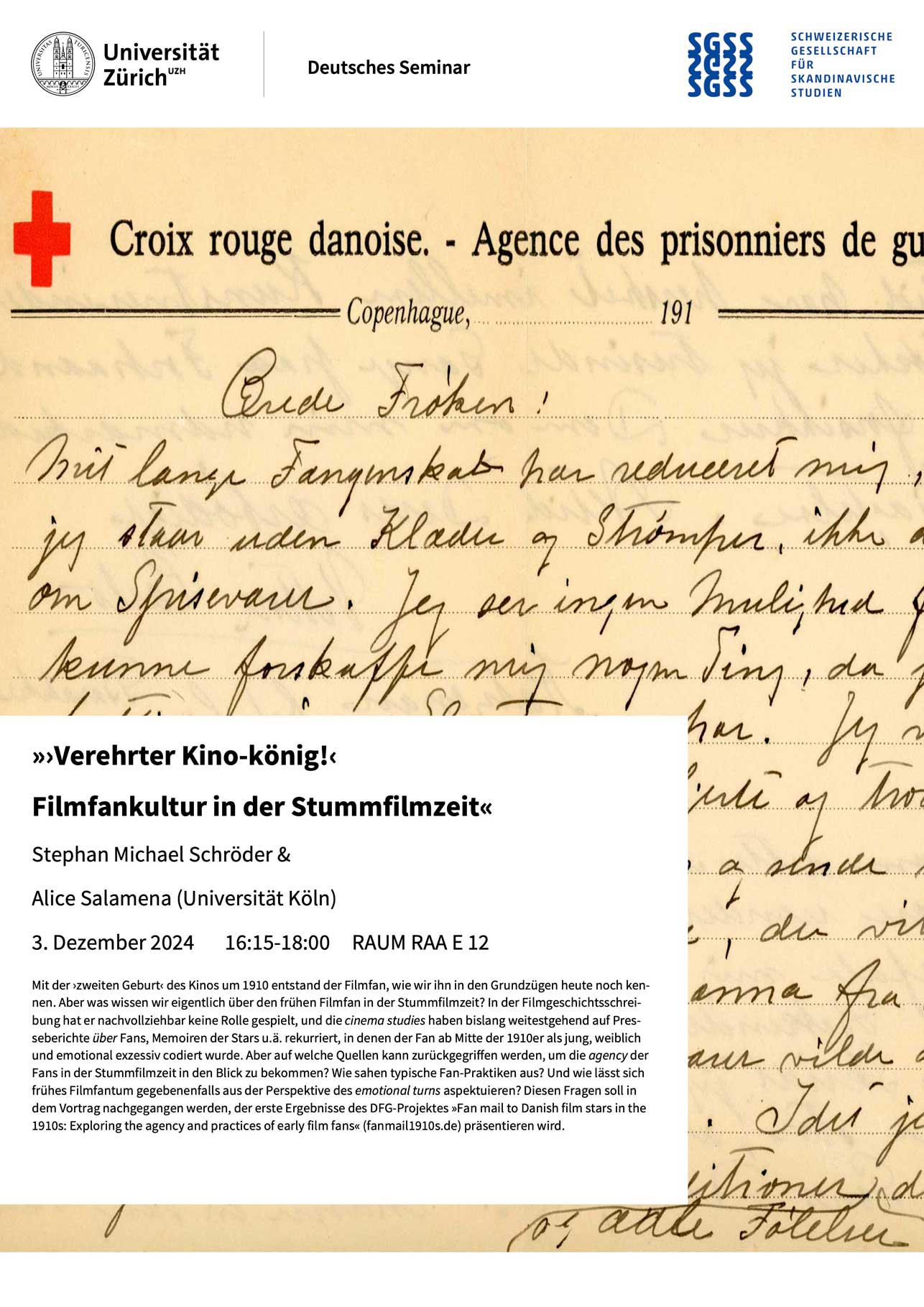Talks & presentations
(since the approval of the application by the German Research Foundation in October 2022)
- Film – Fan – Feeling. (De-)Eroticizing the Star in Silent Film Fandom: Lübeck, Lübeck Film Studies Colloquium, 5.11.2022
(Alice Alessandra Salamena & Stephan Michael Schröder)
Abstract:
In the media of the 1910s, the film fan became quickly transformed into an object of ridicule: a young uncritical female prone to go out of her way to participate in the world of the stars even if it was only by drooling over pictures of her admired celebrities. Fan mail collections, however, allow for a much more differentiated picture of the fan. The fans constructed eroticized images of the celebrities they were writing to, even secretly enacting in their texts gender identities that were deemed deviant and immoral. Paradoxically at first sight, this is paralleled by an increasing tendency to reduce communication with stars to simple requests for autographs, turning the star from an object of subjective desire into a commodified collectable. By highlighting different ways in which fans addressed celebrities in fan mail, the presentation discerned strategies fans employed to eroticize or de-eroticize Danish stars, as well as act out their own gender identities in the secret safe space of the fan letter.
- Film – Fan – Feeling. (De-)Eroticizing the Star in Silent Film Fandom: Copenhagen, Silent Film Fandom and Celebrity Culture, Digital Methods for New Historiographies, 20.1.2023
(Alice Alessandra Salamena) - Film – Fan – Feeling. Die (De-)Erotisierung des Stars im Fantum der Stummfilmzeit: Munich, Ludwig-Maximilians-Universität, 25.1.2023
(Alice Alessandra Salamena & Stephan Michael Schröder) - Fan mail to Danish film stars in the 1910s. Präsentation des DFG-Projektes: Universität Bonn, Tag der Forschung, 6.5.2023
(Stephan Michael Schröder) - Verehrer und Bewunderer – aber keine Fans im Theater? Universität Bonn, Tag der Forschung, 6.5.2023
(Alice Alessandra Salamena) - Manners make a ›Backfisch‹. Performing Female Adolescence in Silent Cinema: Lübeck, Lübeck Film Studies Colloquium, 3.11.2023
(Alice Alessandra Salamena & Stephan Michael Schröder)

Abstract:
By the end of the 19th century, adolescence emerged as a new life phase in its own right between childhood and adulthood. The cinema became a discursive field for constituting and negotiating this phase, as youth (as well as gender, race and class issues) was at the heart of the discussions about the perils of the new media. Especially the ›Backfisch‹ (a German term for an adolescent girl, even used in Scandinavia and the USA) was eyed suspiciously by the cultural elite: The ›Backfisch' stood for a dangerous mix of naïvety and scheming, potentially threatening sexual norms by adapting male-coded behaviour in her performance of adolescence. In our presentation we explore Danish and German cinematic negotiations of the ›Backfisch‹ as stereotypical form of female adolescence highly informed by the emerging discourse on youth around 1900.
- Fan Mail to Danish Film Stars in the 1910s: Cologne International Forum: Salon, 6.12.2023
(Alice Alessandra Salamena & Stephan Michael Schröder) -
Fan Mail to Danish Film Stars in the 1910s: Danish Film Institute, Copenhagen, 25.1.2024
(Alice Alessandra Salamena & Stephan Michael Schröder)
(Picture: © Veronika Foss) - Fan Mail to Danish Film Stars in the 1910s: Method Lab of the AG Partizipations- und Fanforschung, 3.5.2024
(Alice Alessandra Salamena & Stephan Michael Schröder) -
Datenprozessierung und -visualisierung. Ein Werkstattbericht aus dem Fanbrief-Projekt (Dataprocessing and datavisualization: A workshop report from the fanmail project): Cologne, Tag der Forschung, 8.6.2024
(Stephan Michael Schröder) - Fan Mail to Danish Film Stars in the 1910s. Poster presentation: Bonn, 26. Arbeitstagung der Skandinavistik, 24.–26.9.2024
(Alice Alessandra Salamena) - Fan Mail to Danish Film Stars in the 1910s. Pitch presentation: Cologne, Cologne Center for eHumanities (CCeH), 14.10.2024
(Alice Alessandra Salamena & Stephan Michael Schröder) - On the Continuities of Fannish Practices: Fan Letter Writing to Theatre Stars and Film Stars: Cologne-Wahn, Fans in the Theatre? About unbeloved fannish spectators and theatre's self-image 1860-1920, 25.10.2024
(Alice Alessandra Salamena)



Abstract:
The project ›Fan Mail to Danish Stars in the 1910s: Exploring the agency and practices of early film fans‹ investigates different film fan letter collections from the 1910s to explore how cinema history and film fandom tie into each other. Obviously, writing fan letters to stage stars, authors and public personalities of all sorts was an established fan practice long before film. Nevertheless, something happened to this practice in the early 20th century: In the media landscape of the 1910s, and with the rise of the cinematic feature film, (film) fandom received considerable media attention and became internationally visible. This paper presented the fan letter collection to Betty Nansen (1873-1943), who received fan letters addressing as a theatre star and fan letters addressing her as a film star, with the aim of examining whether there were differences between fan letters to theatre stars and fan letters to film stars, what these differences are, and what might account for them.
- Acquiring Actors and Actresses: Theatre Stars and Film Stars on Postcards: Cologne-Wahn, Fans in the Theatre? About unbeloved fannish spectators and theatre's self-image 1860-1920, 25.10.2024
(Stephan Michael Schröder)

Abstract:
This paper explores the continuities and discontinuities between theatre fandom and early film fandom in the 1910s by focusing on the representation of actors and actresses on postcards and the practices associated with these cards, drawing on a wide selection of both postcards and fan letters. It argues that while the practice of collecting actors and actresses on postcards was by no means new, the purely medial relationship between film star and fan implied a perceptual distance that had to be bridged. In order to assure oneself of the ontological existence of the actor or actress behind his or her morphological cinematic shadow, civil portrait cards, ideally autographed, were preferred to character portraits showing the actors ›in character‹. Thus, the transition from picture personalities, revered for their diegetic, per se morphological performance, to extradiegetic stars in the 1910s was both reflected and encouraged by the postcards on sale, which were the main print medium for fans in that decade.
- Continuities and Discontinuities in Fandom in the 1910s – Two Brief Case Studies: Lübeck, Lübeck Film Studies Colloquium, 8.11.2023
(Alice Alessandra Salamena & Stephan Michael Schröder)
Abstract:
In the context of our project »Fan mail to Danish film stars in the 1910: Exploring the agency and practices of early film fans«, the talk will deal with the question of continuity and discontinuity between pre-cinema fandom practices and the emerging film fandom practices in the 1910s. Practices considered typical of film fandom such as asking for autographs, putting up pictures, reading up on stars and their private lives in magazines, sending gifts, etc. were in fact far from new. But are there nevertheless significant differences between the practices of pre-cinema fandom and film fandom – and how might they be explained?
- ›Verehrter Kinokönig!‹ Filmfankultur in der Stummfilmzeit: Zürich, Universität Zürich, 3.12.2024
(Alice Alessandra Salamena & Stephan Michael Schröder) - Fan Mail to Danish Film Stars in the 1910s: 20. überregionale Promovierendentagung der Skandinavistik, Tübingen, Eberhard Karls Universität Tübingen, 29.3.2025
(Alice Alessandra Salamena) - Historische Fanforschung: Probleme und methodologische Fragen: Universität Bonn, Tag der Forschung, 24.5.2025
(Stephan Michael Schröder) - Fanbreve til danske stumfilmstjerner: Landsforeningen for Film og Foto: Copenhagen, 12.6.2025
(Stephan Michael Schröder)


(DFI, Olaf Fønss collection, no. 320)
